
Bruno Louis Zimm (December 29, 1867 - November 21, 1943) was an American sculptor. He created a variety of works: fountains, memorials, freestanding sculptures, and architectural sculptures.

Bruno Louis Zimm (December 29, 1867 - November 21, 1943) was an American sculptor. He created a variety of works: fountains, memorials, freestanding sculptures, and architectural sculptures.
He was born in New York City, the son of Louis and Olga Shoreck Zimm. [1]
At age 13, Zimm began study at the Metropolitan Museum of Art Schools, [2] where J.Q.A. Ward was among his instructors. [3] He studied privately for five years under Karl Bitter, [2] for a year under Augustus Saint-Gaudens at the Art Students League of New York, then worked as a studio assistant to Saint-Gaudens. [1] Zimm's early work included architectural sculpture for the Hotel Waldorf-Astoria, and an angel figure for Trinity Church Cemetery. [2] He studied further in Paris, [1] where he received an 1899 commission from the U.S. Government to create two sculpture groups for the upcoming Exposition Universelle (1900). [2]
In the [American] section of "Varied Industries," Mr. Bruno Louis Zimm of New York has just finished the first of the two sculpture groups that are to flank its entrance. It is a very graceful and dignified composition representing the art of Ceramics—a female figure engaged in the decoration of a vase, while a youth holds before her a bunch of freshly culled leaves. The sentiment is, that all true art is inspired by nature. [4]
Following his return to New York City, Zimm created a statue of General Sherman, a sculpture group called Progress, and a number of bas-relief panels and portrait busts. [2]
Zimm was commissioned to create a statue of Sacagawea for the 1904 World's Fair. His research into her turned up new evidence: "A sculptor, Mr. Bruno Zimm, seeking a model for a statue of Sacagawea that was later erected at the Louisiana Purchase Exposition in St. Louis, discovered a record of the pilot-woman's death in 1884 (when ninety-five years old) on the Shoshone Reservation, Wyoming, and her wind-swept grave." [5] Zimm also created the colossal Allegorical Figure of North Dakota for the Fair, one of fourteen seated sculptures representing the U.S. states that had been part of the Louisiana Purchase. In addition, he created architectural sculptures for some of the buildings.
Zimm was awarded a Silver Medal at the 1900 Paris Exposition for his sculpture groups, The Art of Metalwork and The Art of Ceramics. [1] He exhibited at the 1904 Louisiana Purchase Exposition in St. Louis, Missouri; and the 1915 Panama–Pacific International Exposition in San Francisco, California. [1] He was elected to membership in the National Sculpture Society in year. [1]
In 1910 Zimm moved full-time to the Byrdcliffe Colony in Woodstock, New York. [6] In 1919 he married his second wife, Louise Seymour Hasbrouck. [1] Their son Bruno Hasbrouck Zimm (1920-2005) became a well known chemist.
Zimm and his wife purchased a farm outside Woodstock during the 1930s. It featured an 1840s stone farmhouse, that they renovated and expanded in an Arts and Crafts style. Zimm's two-story studio features rafter tails carved into masks, and interior carving, including one plaque reading: "Rose Plot, Fringed Pool, Fern'd Grot, the veriest school of Peace." [7]


George Grey Barnard, often written George Gray Barnard, was an American sculptor who trained in Paris. He is especially noted for his heroic sized Struggle of the Two Natures in Man at the Metropolitan Museum of Art, his twin sculpture groups at the Pennsylvania State Capitol, and his Lincoln statue in Cincinnati, Ohio. His major works are largely symbolical in character. His personal collection of medieval architectural fragments became a core part of The Cloisters in New York City.

Edward Clark Potter was an American sculptor best known for his equestrian and animal statues. His most famous works are the marble lions, nicknamed Patience and Fortitude, in front of the New York Public Library Main Branch
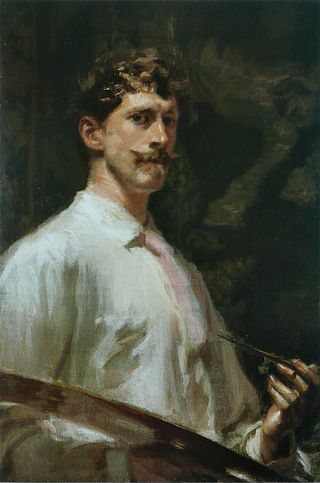
Frederick William MacMonnies was the best known expatriate American sculptor of the Beaux-Arts school, as successful and lauded in France as he was in the United States. He was also a highly accomplished painter and portraitist. He was born in Brooklyn Heights, Brooklyn, New York and died in New York City.

Karl Theodore Francis Bitter was an Austrian-born American sculptor best known for his architectural sculpture, memorials and residential work.

Alexander Stirling Calder was an American sculptor and teacher. He was the son of sculptor Alexander Milne Calder and the father of sculptor Alexander (Sandy) Calder. His best-known works are George Washington as President on the Washington Square Arch in New York City, the Swann Memorial Fountain in Philadelphia, and the Leif Eriksson Memorial in Reykjavík, Iceland.
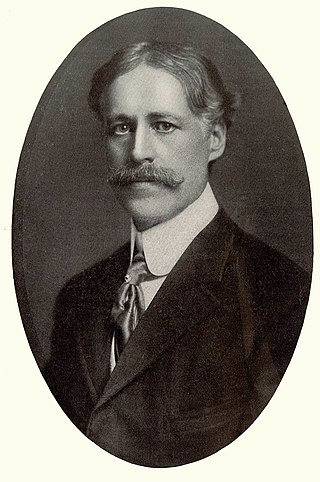
William Ordway Partridge was an American sculptor, teacher and author. Among his best-known works are the Shakespeare Monument in Chicago, the equestrian statue of General Grant in Brooklyn, the Pietà at St. Patrick's Cathedral in Manhattan, and the Pocahontas statue in Jamestown, Virginia.

Charles Allan Grafly, Jr. was an American sculptor, and teacher. Instructor of Sculpture at the Pennsylvania Academy of the Fine Arts for 37 years, his students included Paul Manship, Albin Polasek, and Walker Hancock.

Evelyn Beatrice Longman was a sculptor in the U.S. Her allegorical figure works were commissioned as monuments and memorials, adornment for public buildings, and attractions at art expositions in early 20th-century America. She was the first woman sculptor to be elected a full member of the National Academy of Design in 1919.

Isidore Konti was a Vienna-born sculptor. He began formal art studies at the age of 16 when he entered the Imperial Academy in Vienna, where he studied under Edmund von Hellmer. In 1886, he won a scholarship that allowed him to study in Rome for two years. While there he developed a love of Renaissance art that was to affect the nature of his mature sculpture. Upon returning to Austria, Konti worked as an architectural modeler.

Allen George Newman III was an American sculptor, best known for his statue "The Hiker".
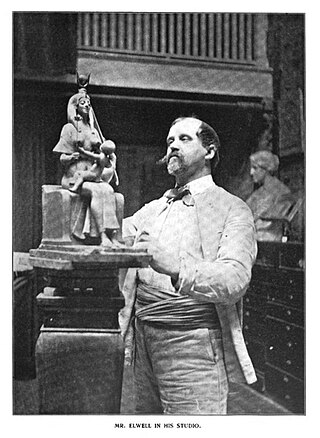
Francis Edwin Elwell was an American sculptor, teacher, and author.

Albert Jaegers was an American sculptor.
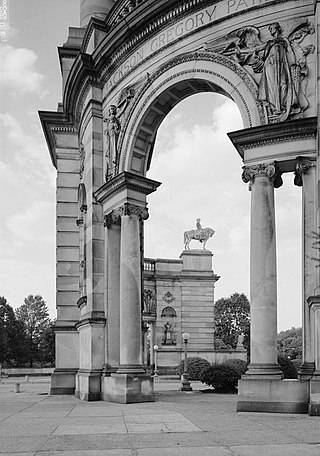
Smith Memorial Arch is an American Civil War monument at South Concourse and Lansdowne Drive in Philadelphia, Pennsylvania. Built on the former grounds of the 1876 Centennial Exposition, it serves as a gateway to West Fairmount Park. The Memorial consists of two colossal columns supported by curving, neo-Baroque arches, and adorned with 13 individual portrait sculptures ; two eagles standing on globes; and architectural reliefs of 8 allegorical figures.

Elsie Ward (1871–1923) was an American sculptor born in Fayette, Missouri. Her collection largely consists of bronze and other metal sculptures. Ward worked on a host of diverse works of art, but "her specialty was portraits, busts, and reliefs".

William Clark Noble was an American sculptor best known for his monuments.

Johannes Sophus Gelert (1852-1923) was a Danish-born sculptor, who came to the United States in 1887 and during a span of more than thirty years produced numerous works of civic art in the Midwest and on the East Coast.

Fernando Miranda y Casellas was a Spanish-American sculptor, architectural sculptor and illustrator.
Clement John Barnhorn (1857–1935) was an American sculptor and educator known for his memorials, architectural sculpture, and ecclesiastic and funerary works.
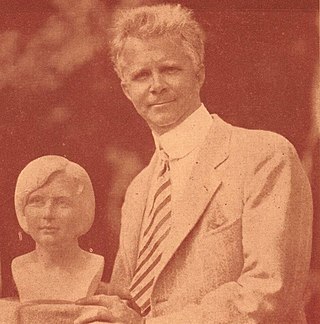
Roger Noble Burnham was an American sculptor and teacher. He is best remembered for creating The Trojan (1930), the unofficial mascot of the University of Southern California.

Bruno Mankowski, was a German-born American sculptor, carver, ceramicist and medalist.